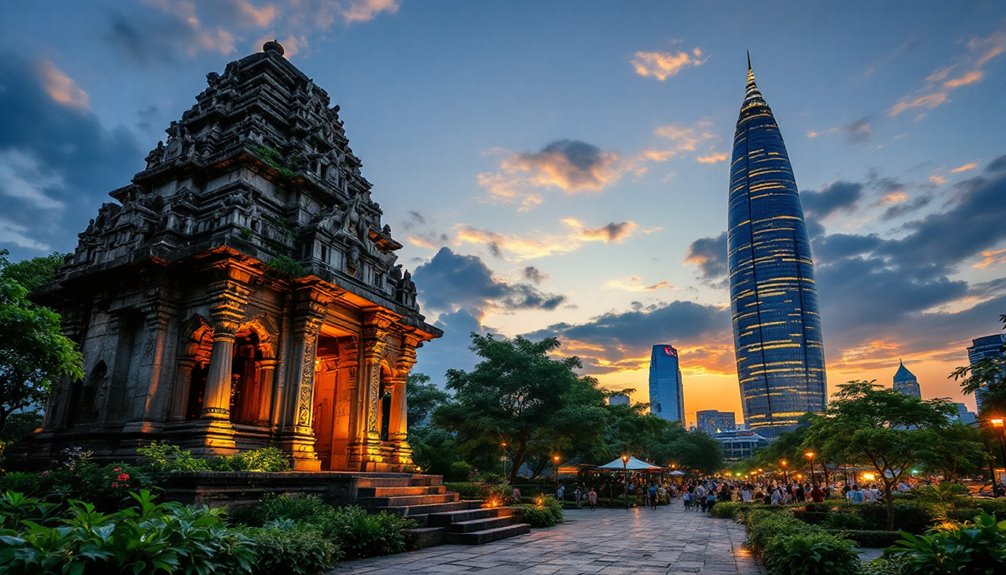Most travel writers overlook the subtle yet powerful interplay between ancient traditions and contemporary life in their narratives. You have the unique opportunity to spotlight these contrasts by capturing the essence of places where history and modernity collide. Think about how a centuries-old market thrives beside a sleek café or how a historic church stands proudly against a backdrop of urban hustle. This exploration not only enriches your storytelling but also invites your audience to feel the pulse of these destinations. So, how do you effectively convey these contrasting elements in your work?
Understanding Contrasts in Travel Writing
Contrasts in travel writing serve as a powerful tool to paint a vivid picture of a destination. By highlighting the unique character of a place, you can engage readers and spark their curiosity. Think about the narrative techniques you can use to showcase the differences between historical and modern elements, cultural variations, and geographical diversity. This approach creates a dynamic and engaging narrative that makes the destination more intriguing.
When you describe a bustling market filled with the aroma of spices juxtaposed against sleek, glassy skyscrapers, you're not just telling a story; you're using visual storytelling to involve your audience in the experience. Use descriptive language that evokes the senses, helping readers to see, smell, and hear the contrasts you encounter. Essays depend on facts but travel writing allows for a more emotional and personal connection to the narrative.
Anecdotes about your personal experiences can also bring these contrasts to life. For instance, if you've stood in front of an ancient temple, feeling its history while hearing the chatter of modern life around it, share that moment. By weaving together different aspects of the destination, you not only inform but also create a narrative that resonates emotionally, making your writing both compelling and memorable.
Identifying Contrasts in Destinations
In exploring a destination, you'll often find striking contrasts that reveal its true character. Take a walk through the contrasting neighborhoods of a city, and you'll likely encounter both opulence and poverty side by side. Visualize luxurious high-rises looming over bustling street vendors in Los Angeles or the lively favelas of Rio. These economic contrasts highlight not just wealth disparities, but also how they shape local culture and daily life.
Architectural contrasts can be just as eye-catching. Picture ancient temples tucked away among modern skyscrapers in Kuala Lumpur or Edinburgh, where history and innovation stand together, almost like old friends catching up over coffee. Each building conveys a narrative, showcasing different materials and construction techniques that span generations. Understanding cultural nuances can further deepen your appreciation of these architectural contrasts.
Then there are the sensory experiences that create a rich fabric of life. The sounds of street musicians blend with the aroma of gourmet food trucks, while the textures of leather and wool playfully compete for your attention. In these moments, you grasp the essence of a place, making your travels all the more memorable. So, keep your eyes and senses open—these contrasts are what make each destination unique and fascinating!
Techniques for Describing Contrasts

When you submerge in the art of describing contrasts, sensory details can transport your readers right into the heart of a destination. Picture walking through a bustling traditional market where the aroma of spices dances in the air, then, just around the corner, you're hit by the rich scent of brewed coffee wafting from a sleek modern café. By using sensory descriptions like these, you pull readers into this experience. Show, don't tell allows you to create a vivid picture that resonates with your audience.
Engage storytelling techniques to frame your narrative. Introduce a local guide who navigates the old stone alleys while sharing anecdotes of the new skyscrapers that tower above. Incorporate dialogue between characters from different generations, revealing their contrasting perspectives.
To keep things fresh, avoid clichés and paint vivid images instead. Describe ancient buildings as "aging giants" standing watch over "sleek skyscrapers" that scream innovation.
Finally, structure your narrative with an intriguing introduction and a clear journey through contrasts. Highlight key moments and wrap up with reflections that tie everything together, leaving readers with a sense of wonder about the beauty in blending the old with the new.
Blending History With Modernity
Every traveler knows the thrill of discovering how history and modernity intertwine in lively cities like Cork and Lisbon. In Cork, you can wander through the stunning St. Fin Barre's Cathedral, where intricate architecture and stained glass windows whisper tales of the city's ecclesiastical past. Just a short stroll away, the Cork City Gaol, now a museum, contrasts dramatically with its former life as a prison, showcasing the city's journey of historical preservation.
Then there's Shandon Tower, offering breathtaking views that blend the old and new, making it a must-visit for any tourist. In Lisbon, the Belem Tower and Jeronimos Monastery stand proudly alongside modern twists, illustrating the architectural evolution that defines this energetic city. Visitors to Lisbon can indulge in luxury accommodations such as Pousada de Lisboa, which combines elegance with historical significance.
You'll find places like the Crawford Art Gallery, where historical buildings house contemporary art, perfectly merging past and present. While you explore, you'll notice how Cork's English Market, with its rich traditions, shakes hands with modern shopping experiences. This blend creates a rich mosaic that not only enhances your visit but also gives you a deeper appreciation for how cities can honor their roots while embracing the future.
Exploring Cultural Contrasts

Experiencing the rich fabric of cultural contrasts in travel offers a deeper understanding of a region's identity. Take Colombia, for instance, where the Antioquia Department showcases a blend of Indigenous traditions and colonial influences, especially through the unique Paisas cultural group. You'll taste this diversity in their lively cuisine, hear it in their music, and feel it in the spirited streets of Medellin—once troubled, now transformed into a cultural hub. This journey often provides learning opportunities that enhance your understanding of local customs.
Similarly, Ecuador surprises you with its mix of Andean and Amazonian Indigenous cultures, alongside Spanish colonial influences. Envision celebrating a colorful festival on the coast, only to retreat to the serene mountains where ancient traditions thrive.
Then there's Vietnam, where French colonialism meets Chinese heritage, creating a fascinating urban landscape filled with charming architecture and delicious street food.
In Thailand, you'll find bustling Bangkok, where modern life intertwines with traditional temples, and Chiang Mai, where festivals celebrate age-old customs. Each destination bursts with cultural diversity, inviting you to explore contrasts that tell profound stories. So, pack your bags and get ready for a journey that's as enlightening as it is thrilling!
People are Asking
How Do I Choose Which Contrasts to Focus On?
To choose contrasts, focus on historical landmarks and cultural traditions that resonate with you. Consider what captures your interest or surprises you, as these elements will create a more engaging narrative for your audience.
What Tools or Resources Help in Researching Contrasts?
To research contrasts, you've got multimedia resources and visual storytelling at your fingertips. Use online databases, engage local guides, and explore sensory details, blending history and modernity for a richer understanding of your destination.
Can I Use Personal Experiences to Highlight Contrasts?
Your personal anecdotes can vividly highlight contrasts. By sharing cultural reflections, you create a unique narrative that resonates with readers, allowing them to experience the differences through your eyes and emotions.
How Do I Ensure Accuracy in My Descriptions?
To guarantee accuracy in your descriptions, use fact checking strategies like verifying names and details. Incorporate sensory details to create vivid imagery, making your writing both engaging and truthful for your readers.
What Are Common Pitfalls to Avoid When Writing About Contrasts?
Charting a fabric of contrasts, you must weave cultural sensitivity into your narrative. Avoid vague descriptions and clichéd phrases; guarantee thematic coherence by highlighting specific elements that genuinely reflect the destination's unique duality.
Wrapping up
While you wander through a city where ancient cathedrals stand proudly beside sleek skyscrapers, you might wonder if these contrasts could clash. But instead, they create a lively mosaic of life—where the past whispers stories as modern art bursts with color. You'll find bustling markets filled with laughter and the aroma of spices, all while a serene ritual unfolds nearby. Cherish the beauty of these juxtapositions; they're the heartbeats of a destination, inviting you to explore more.